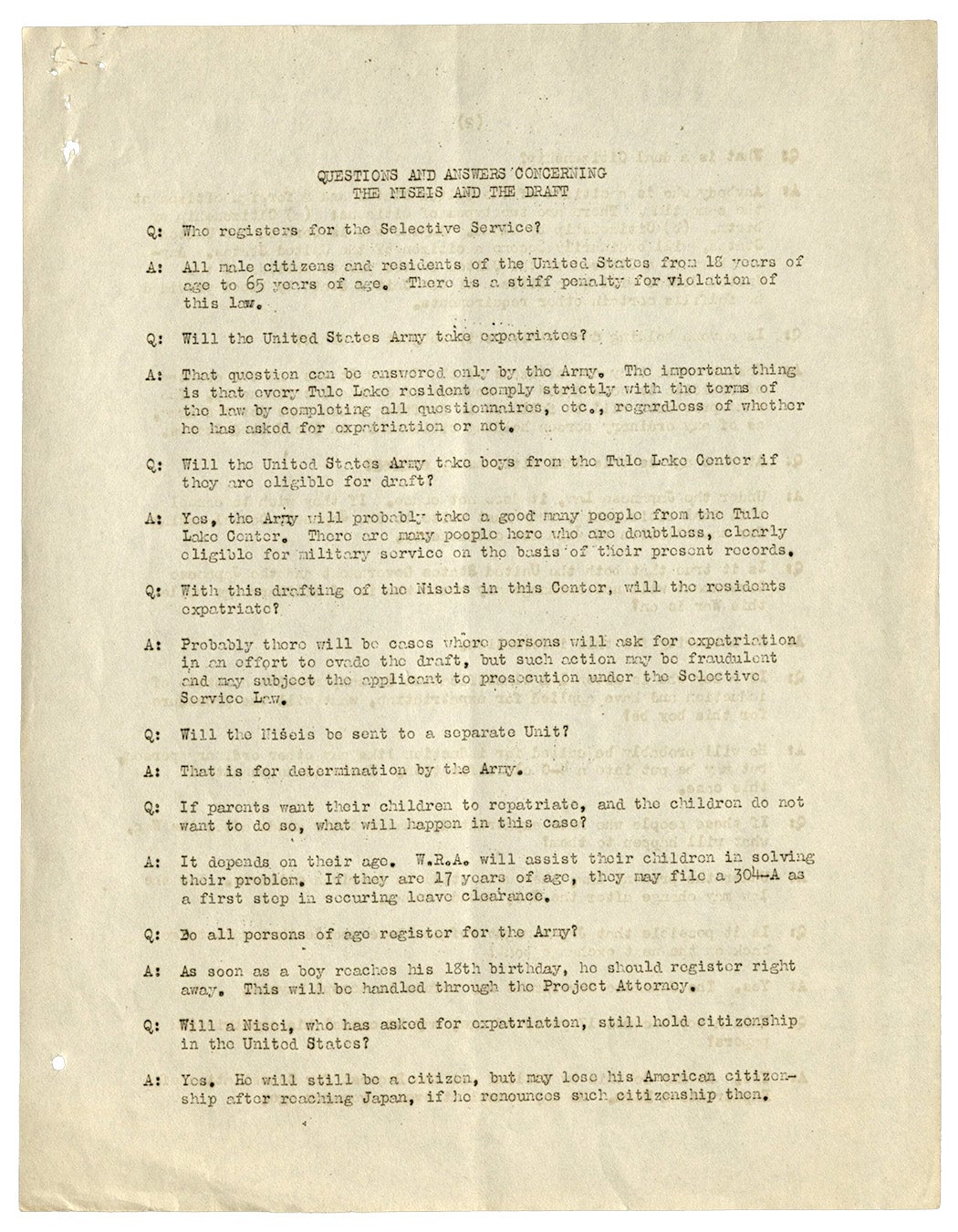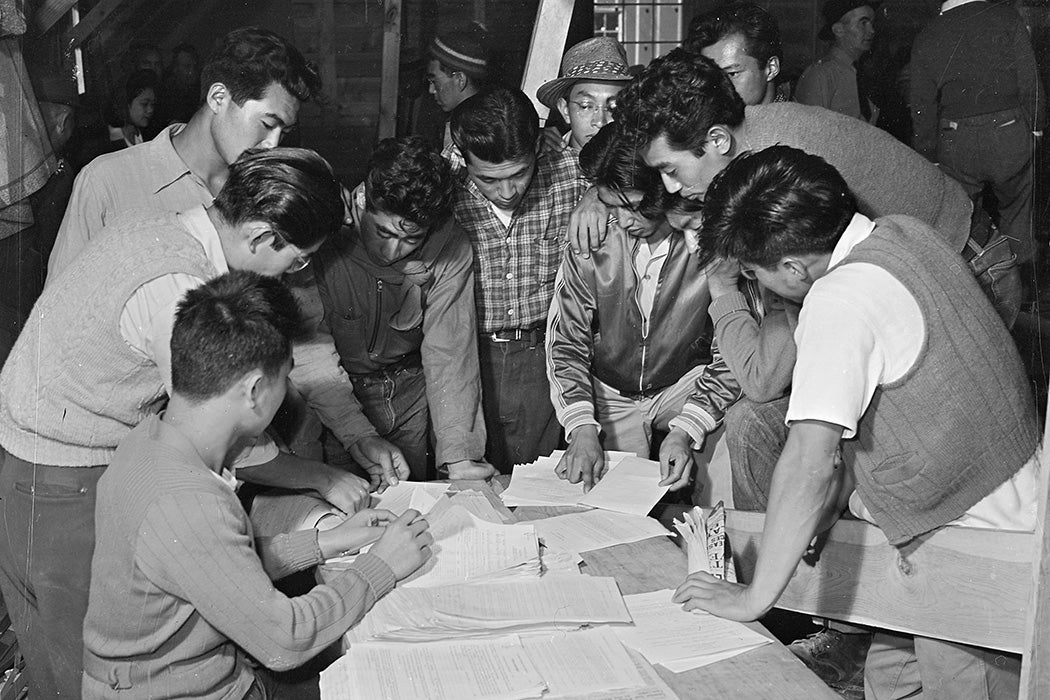The internment of Japanese Americans during World War II was an unfortunate episode redeemed by the heroic efforts of Japanese American soldiers serving in the United States military. That, at least, was the story promulgated by many after the war. The Army’s segregated 442 Regimental Combat Team, for example, was the “most decorated unit for its size and length of service in the history of the US military.” They fought through Italy, France, and Germany even as their parents and siblings were among the approximately 120,000 Japanese Americans, most of them citizens, forced to live in concentration camps for the duration of the war, stripped of their possessions, property, and rights.
For the Japanese American Citizens League, the mainstream voice of the Japanese American community during the war, these soldiers proved the loyalty of the Nisei (second-generation Japanese Americans). Death in combat was the ultimate proof of their Americanness. For years after the war, the bravery of these soldiers was touted as exemplary, the model of loyalty under both literal and metaphorical fire.
As historian Arthur A. Hansen details, the JACL didn’t want another kind of loyalty in the internment camps to become part of the official story. This was the history of the young Nisei men who resisted the draft, who didn’t believe they should be forced to serve a government which had stripped them of their citizenship rights and kept them and their family members in remote, grim camps merely because they were of Japanese ancestry. Or that their deaths were necessary to prove their patriotism.

This story only really began to be told in the late 1960s, in the context of the Civil Rights movement and the draft resistance to the Vietnam War. It has since become a significant part of the historiography.
In early 1942, following the Imperial Japanese attack on Pearl Harbor, Japanese Americans were banned from US military service as security risks, with those already serving taken off active duty. The following year, in January 1943, however, Japanese American were allowed to volunteer for service. Of those who volunteered, most joined the Army, where they were placed in segregated units. Many of the initial volunteers hailed from Hawaiʻi, where Japanese Americans were not relocated as on the mainland. In February 1944, the War Department listed Japanese Americans in the Selective Service system, meaning that they could be drafted.
Should they be drafted was the question at the Heart Mountain “War Relocation Center” in northwestern Wyoming. At its peak occupancy, Heart Mountain held 10,767 Japanese Americans. The Heart Mountain Fair Play Committee (FPC) was formed in late 1943, even before the draft applied to them because inmates were obliged to fill out a loyalty questionnaire, one of whose questions asked, “Are you willing to serve in the armed forces of the United States wherever ordered?”
At its peak, the FPC had some 275 dues-paying members. Sixty-three Heart Mountain Nisei who refused to undergo their pre-induction physicals were indicted for breaking the law. The leadership of FPC was indicted for conspiring to help them do so.
Primary Sources
Denver-based journalist and editor James Matsumoto Omura was also indicted with the FPC leadership on the charge of conspiring with them. Omura and his business partner and wife Fumiko Okuma had been outspoken at the Congressional hearings on “national defense migration” in San Francisco in early 1942. While the JACL’s representatives testified that the government could depend on the complete cooperation of Japanese Americans in their evacuation and incarceration, Omura and Okuma condemned what the JACL called “constructive cooperation.” Omura’s fiercely patriotic questions at those hearings ring out still.
“Has the Gestapo come to America?” he asked. “Have we not risen in righteous anger at Hitler’s mistreatment of Jews? Then is it not incongruous that citizen Americans of Japanese descent should be mistreated and persecuted?”
Weekly Newsletter
The conservative JACL and the radical Omura feuded for years. As it happened, Omura wasn’t convicted because of the First Amendment, and the FPC leadership convictions would be overturned on appeal. But a total of three hundred and fifteen Nisei from ten different camps were sentenced to jail for their refusal to be drafted by the government that kept their families in camps. Most were sentenced to two years of imprisonment. President Harry S. Truman issued a blanket pardon for them after the war.
Not all the draft resisters were taken to trial. Judge Louis Goodman dismissed the indictment against seven of them in the Tule Lake, California, camp, noting that it was “shocking to the conscience that an American citizen be confined on the ground of disloyalty and then, while so under duress and restraint, be compelled to serve in the armed forces or be prosecuted for not yielding to such compulsion.”
Teaching Tips
JSTOR includes many collections related to the incarceration of Japanese Americans during World War II. In addition the University of Pacific collections listed above, students can explore:
- The Japanese American World War II Incarceration collection from The Claremont Colleges covers a range of subjects central to Japanese American life before, during, and after World War II.
- The Japanese Internment Collection from University of La Verne contains text and images recognizing Japanese Internment in California.
- The Turlock Assembly Center newsletter from California State University, Stanislaus shares news about events in the prison camp between June 3 and July 17, 1942.







